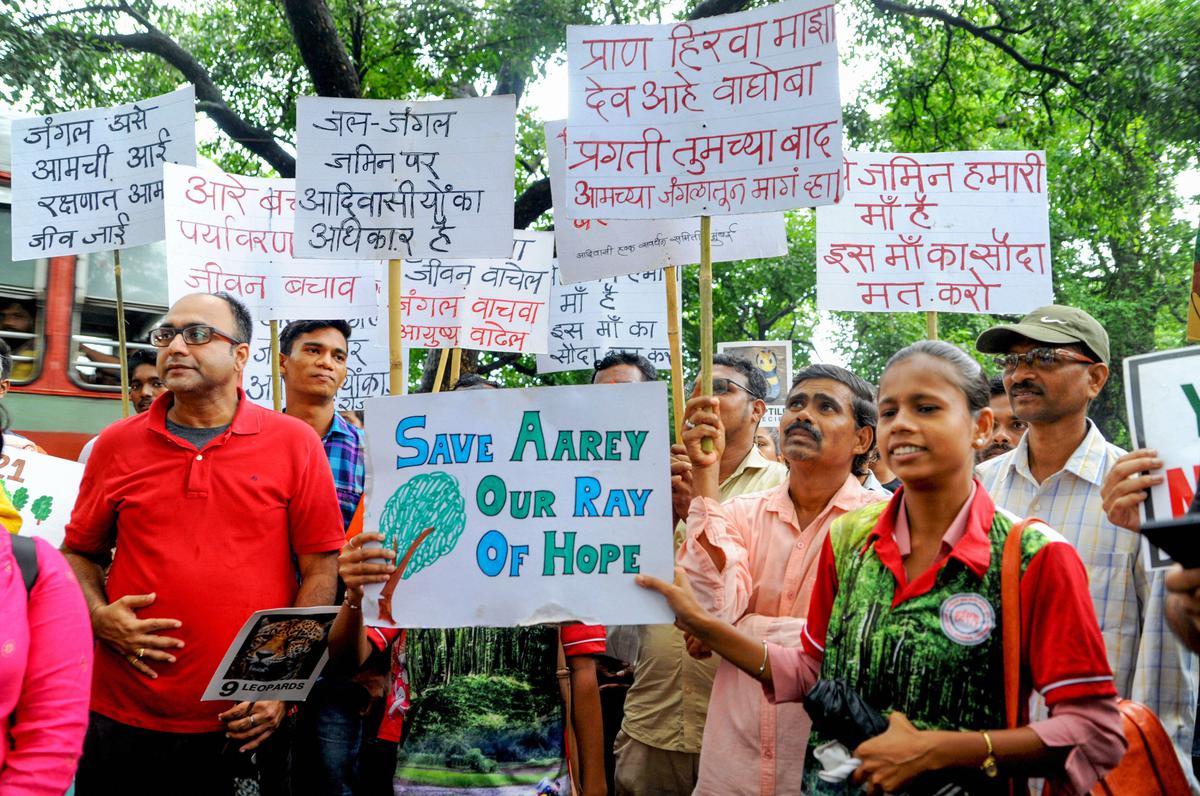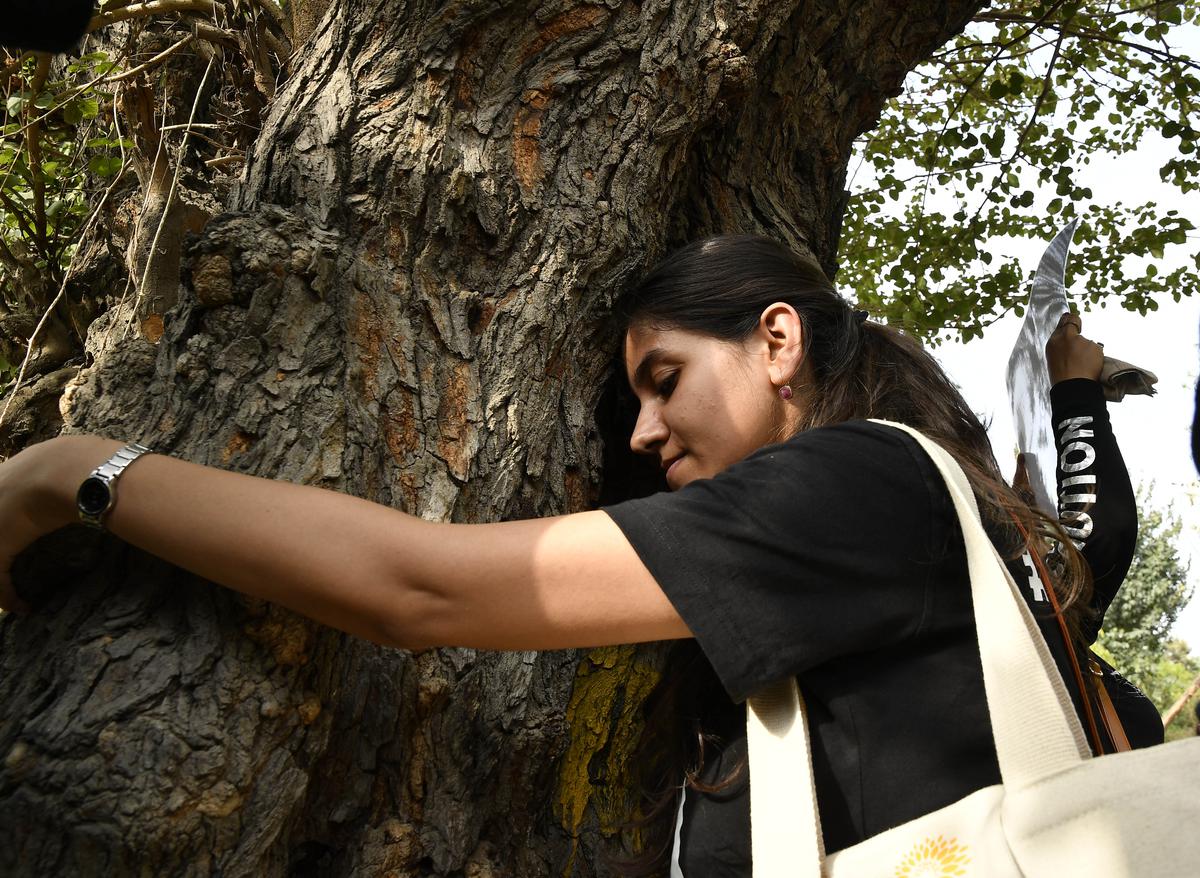In the summer time of 2019, a gaggle of 15 individuals who name themselves ‘Nature Lovers of Hyderabad’ got here collectively to save lots of an irreplaceable tract of native heritage: practically 1,000 banyan bushes, many a century previous, slated to be felled for a freeway widening undertaking on a 46-km stretch between Hyderabad and Manneguda.
These banyans are extra than simply aesthetic foliage: they’re habitat to birds of prey and different wildlife; they’re a part of a heritage bequeathed by the Nizam who planted them alongside an avenue; and so they assist native economies — distributors promote fruits, greens and roasted corn beneath their cover.
By the tip of 2022, over 63,000 individuals had signed a change.org petition to ‘Save the banyans of Chevella’ on this Telangana freeway. The felling has not but begun, however Sadhana Ramchander, a member of the marketing campaign, has observed some ominous indicators of improvement on this stretch. “Wild vegetation has been cleared along the road and some trees have been marked with paint for translocation,” she says.
The group has geo-tagged 914 bushes and filed a petition with the National Green Tribunal. “The tribunal has directed the National Highways Authority of India (NHAI) to not fell or translocate trees, but the highways authority is yet to respond,” says Ramchander. Sources on the highways authority have knowledgeable the group that over 200 bushes shall be spared the axe, and that a number of shall be translocated. “These are big trees and in all likelihood will not survive translocation.”
As this goes to press, environmental activist Kolipaka Prakash is main a 200-km padayatra from Warangal to Manneguda in protest.
Participants of the 200 km padayatra to ‘Save the banyans of Chevella’ in Hyderabad.
| Photo Credit:
Special Arrangement
Striking on the root
Across city India, civil society teams are bravely and innovatively rising to guard their metropolis’s treescape, even courting arrest. They use each device at their disposal: protests, petitions, judicial activism, social media campaigns and the Right to Information Act.
Timely motion is essential to the efficacy of those citizen actions. Back in 2018, when Karnataka proposed an modification to the Karnataka Preservation of Trees Act of 1976, including to the listing 50 extra species of bushes that might be felled with out permission — together with gulmohar and mango — a gaggle referred to as Heritage Beku organised a ‘pre-emptive strike’.
They referred to as their marketing campaign ‘Kill Bill’, which, because the title implies, was designed to finish this invoice. “This could have ‘technically’ wiped out 85% of city trees. So we started initiatives like a change.org petition, and ‘Greys for Greens’:. The idea was that the city was going grey, that the citizens were going grey; grey was the colour of concrete. It was reminiscent of the Chipko Movement,” says founding father of the group, Priya Chetty Rajagopal.
“This was a greatly successful programme because it prevented a disastrous thing from happening.” Today, Heritage Beku is launching a undertaking that manufacturers the legacy of serial flowering bushes of Bengaluru, an equal of the Japanese cherry blossom competition.
In the Northeast, activists had much less luck. Some 300 bushes had been felled within the western fringe of Guwahati to widen a highway in March 2022. Many of the bushes had been 80 years previous. This, although a citizen’s group, Fridays for Future, protested, shaped a human chain, and petitioned the Guwahati Metropolitan Development Authority and the NHAI.
In the city jungle
In Mumbai, Prakash Bhoir, 55, is a part of the ‘Save Aarey’ marketing campaign, comprising hundreds of people who find themselves pushing again on a proposed Metro Rail automobile depot undertaking that’s going to value scores of bushes within the 3,000-acre Aarey forest in the course of town. Several protesters have been slapped with FIRs through the years, and a few had been even arrested in 2019.

Citizens protest tree felling in Aarey forest, Mumbai.
| Photo Credit:
PTI
Over the previous 20 years, Aarey has misplaced greater than 100 hectares of vegetation, in keeping with Amrita Bhattacharjee, who’s a part of the marketing campaign and had petitioned the Supreme Court in 2018 difficult the land use change that allowed the development of the Metro depot. No lower than 27 Adivasi hamlets are positioned right here, and lots of of their inhabitants are farmers who additionally rely upon forest assets for his or her livelihood. Bhoir, who belongs to the Malhar Koli tribal neighborhood that grows greens and fruits in Aarey, says he has by no means seen a time, not even in his childhood, when a improvement undertaking didn’t edge its manner into the forest, threatening livelihoods.
Last November, the Supreme Court directed the tree authority, constituted below the Maharashtra (Urban Areas) Preservation of Trees Act, 1975, to take a name on the Maharashtra Metro Rail Corporation’s utility to permit the felling of 84 bushes. No choice has been reached but, and Bhoir isn’t optimistic about the way forward for the Aarey forest. “There will be a time when people will point to it and say, ‘This was once home to tribal communities’.”
The capital’s cover
Since 2018, in Delhi, a whole bunch of residents have been combating to save lots of 16,000 bushes set to be axed for the General Pool Residential Accommodation, a redevelopment undertaking that goals to improve housing for presidency officers.
Activists launched a marketing campaign, #DelhiTreesSoS, on social media in May 2018. Adults and kids got here collectively for avenue marches, candlelight vigils and a tree census.
Then, an orthopaedic surgeon filed a petition within the Delhi High Court arguing that the undertaking was unwise in a metropolis notoriously battling air air pollution. Some invoked the Delhi Preservation of Trees Act, 1994, amongst different laws. But two years later, the High Court judgment went in favour of the undertaking, with modifications to save lots of a couple of bushes. Today, the intrepid campaigners of #DelhiTreeSoS proceed to combat for town’s surroundings.
“Three trees are felled every hour in Delhi, with due permission of the Delhi government. We must remember that this is one of our most polluted cities. We are working on collecting data, influencing policy and convincing the government that there should be a moratorium on tree-felling until we get to an air quality index [AQI] 50,” says Bhavreen Kandhari, who’s a part of #DelhiTreeSoS.

A Delhi resident hugs a tree throughout a protest in Sarojini Nagar
| Photo Credit:
Shiv Kumar Pushpakar
Redoing cities
Some of those civil society-led actions to guard city ecology have been documented in a 2022 report, ‘Regulating Urban Trees in India’, by Manju Menon and Kanchi Kohli of the Centre for Policy Research, Delhi. The report seems at tree legal guidelines applied in a number of States and the way they’re usually not geared up to take care of the extraordinary strain on city ecology from actual property and infrastructure development.
“What we are seeing in most cities now is the expansion of the urban area or redevelopment within the city; large scale projects — redoing cities — were not envisaged in these tree acts,” says Kohli. “And public participation, in terms of public hearing, is not chalked in.”
As for ‘offset measures’ usually promised to make up for tree loss, reminiscent of compensatory afforestation and tree transplantation, they “are based on a flawed developmentalist notion that trees are in the wrong place and that moving them or growing them in another location offers the same socio-ecological benefits provided by those trees that are ‘in the way of development’,” says Kohli and Menon’s report.
For occasion, final yr, the Ministry of Environment, Forest and Climate Change granted Stage 1 clearance to divert 130 sq.km. of rainforest within the Great Nicobar Island for a ₹72,000 crore undertaking that features an airport and a township. Compensatory afforestation shall be carried out miles away within the mainland, in Haryana.
“This is a hugely diverse and rich landscape and also geologically volatile and vulnerable; it happens to be some 100 nautical miles from the epicentre of the 2004 earthquake. Can tree planting in a semi-arid zone, in Haryana, really compensate for the loss of tropical forest in an island system?” asks Pankaj Sekhsaria, a long-term researcher of the Andaman and Nicobar islands.
Felled by the regulation
The Tamil Nadu Hill Stations (Preservatio nOf Trees) Act, 1955, targeted on hilly areas, is the one laws on bushes within the State
The Kerala Preservation of Trees Act, 1986, offers solely with ‘valuable’ tree species reminiscent of sandalwood and rosewood
In Goa, the coconut tree is excluded from The Goa, Daman & Diu Preservation of Trees Act, 1984
In Gujarat, the Saurashtra Felling of Trees Act, 1951, doesn’t specify a definition of felling, damaging or reducing a tree
Source: ‘Regulating Urban Trees in India’
Sustaining cities
Urban forests reminiscent of Aarey or the Delhi ridge are essential for the well being of city-dwellers, however they’re thought-about land that ought to be developed, says Ashish Kothari, a founding father of Kalpavriksh, a nationwide environmental NGO that has campaigned to save lots of the Delhi ridge, one of many world’s largest city forests, habitat to jackals, foxes and 200 species of birds, and as soon as to leopards.
“Globally, in the context of climate change and biodiversity extinction, people’s movements are not just about saving trees outside cities but also within them. How can cities be ecologically sustainable? This is crucial for citizens’ health and wildlife, but also for the urban poor who depend on them for livelihood, collecting leaves, seasonal fruits, firewood, flowers for their own use and sale,” says Kothari, observing that each metropolis ought to have a tree act, fairly other than the State Acts, so as to govern how bushes are managed and guarded in cities.
Iconic greens
In Lalbagh, Bengaluru, stands a virtually 250-year-previous mango tree, the solely surviving one of a trio believed to date again to Tipu Sultan’s time. It nonetheless flowers and produces fruits. There is no proof, nevertheless, to counsel that the bushes had been really planted by Tipu himself. Then, there’s a large African baobab on a knoll in Jhunsi, Prayagraj, shut to the mazar of Sufi saint Baba Sheikh Taqi (1320-84). Legend says he left his datun (toothbrush twig) on the bottom, which then grew into this tree. Radiocarbon relationship has proven it to be 800 years previous, i.e., born a century earlier than the saint. It is additionally one of the two oldest baobabs exterior Africa.
S. Natesh, scientist and former senior advisor with the Department of Biotechnology, who’s penning a e book on India’s iconic bushes (to be revealed by Roli Books)
In Tamil Nadu, final May, the federal government constituted a 10-member State Green Committee to watch tree-felling and shield inexperienced cowl, particularly native species. The committee contains civil society teams reminiscent of Nizhal, a Chennai-based NGO.
Shobha Menon, founding father of Nizhal, says the formation of the committee is a giant step in the direction of the safety of mature bushes throughout public areas within the State. “Indiscriminate tree-felling was once considered so insignificant, it was heartbreaking,” she says. The State can be within the technique of formulating an city tree preservation act. “Several States enacted these laws decades ago and now Tamil Nadu will no longer lag behind,” says Menon.
Meanwhile, activists in Telangana will not be prepared to surrender their combat to save lots of the banyans of Chevella, despite the fact that not a single tree could also be spared. “I want to create awareness among the youth. Ideally, the trees of Chevella should be protected as a heritage site,” says Prakash, who’s main the protest march to Manneguda. “Nowhere in the country is there a road with so many banyans. It is our national tree, after all.”
divya.gandhi@thehindu.co.in


